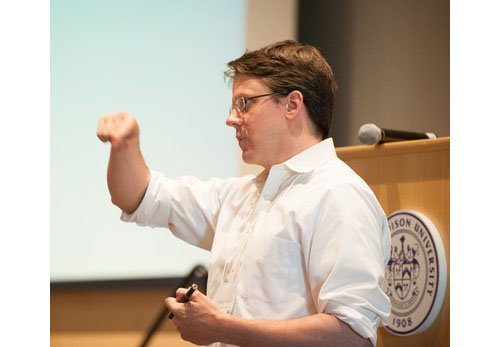Study of Plasmons & Polaritons in Oxide Thin Films
Location
Harrisonburg, VA
Start Date
16-5-2012 4:20 PM
End Date
16-5-2012 4:40 PM
Description
In this presentation we will discuss the role of free electron lasers in the investigation of quasi-particles such as radiative polaritons, bulk plasmons and surface Plasmon polaritons in a variety of oxide thin films including insulating, conducting and highly correlated simple oxides. The first part of the presentation will discuss the case of radiative polaritons. Under broadband and continuous infrared radiation illumination in the 450 – 1100 cm-1 range, these quasi-particles have shown the ability to absorb radiation and transform it into electricity through the heat recovery mechanism. Results acquired with variable incidence angle and polarization will be illustrated. It will then be discussed how a free electron laser such as the one at Thomas Jefferson National Accelerator Facility (TJNAF) could probe more precisely this property of the radiative polaritons by exciting them exactly at their resonance frequency and for the duration of their lifetime (about 10-12 s). The second part of the presentation will involve our recent studies on bulk plasmons and surface Plasmon polariton excitations on conducting oxides such as RuO2. We will discuss our latest results on the metal-insulator transition on VO2 thin films in the ultra-fast time domain and our recent results using THz radiation at the FEL at TJNAF followed by our proposed future FEL-based experiments to investigate relaxation mechanisms in this interesting and important highly correlated oxide system.
Presenter Bio
R. Alejandra Lukaszew, Professor, Physics & Applied Science College of William & Mary
Ale Lukaszew graduated in 1996 from Wayne State University and started her academic career in 2001. She joined the College of William and Mary in 2007 and is currently Distinguished VMEC professor in the Physics and Applied Science departments. She has published more than 65 articles in peer reviewed journals, has filed three patent applications and has received over $5,000,000 in research funding from several federal, state and private sources. Her field of research is experimental condensed matter physics, in the area of thin film and nanostructures, structure and property correlations. Her current research focuses on highly correlated materials such as VO2 in constrained geometries as well as superconducting thin films and multilayers for SRF applications.
Giovanna Scarel Assistant Professor, Physics & Astronomy, James Madison University
Giovanna Scarel received her Laurea Degree in Physics from the University of Trieste (Italy) in June 1994, and a Ph.D. in Materials Engineering from University of Wisconsin-Milwaukee in May 2001. She was a postdoctoral fellow and later Research Associate at the CNR-INFM-Materials and Devices for Microelectronics National Laboratory (Milan - Italy), from June 2001 to July 2007. She worked as a postdoctoral fellow at the Department of Chemical and Biomolecular Engineering of North Carolina State University from August 2007 to July 2009. Giovanna is now an Assistant Professor with the Department of Physics and Astronomy at James Madison University, and has more than 70 published papers in the fields of thin films and spectroscopy.
Study of Plasmons & Polaritons in Oxide Thin Films
Harrisonburg, VA
In this presentation we will discuss the role of free electron lasers in the investigation of quasi-particles such as radiative polaritons, bulk plasmons and surface Plasmon polaritons in a variety of oxide thin films including insulating, conducting and highly correlated simple oxides. The first part of the presentation will discuss the case of radiative polaritons. Under broadband and continuous infrared radiation illumination in the 450 – 1100 cm-1 range, these quasi-particles have shown the ability to absorb radiation and transform it into electricity through the heat recovery mechanism. Results acquired with variable incidence angle and polarization will be illustrated. It will then be discussed how a free electron laser such as the one at Thomas Jefferson National Accelerator Facility (TJNAF) could probe more precisely this property of the radiative polaritons by exciting them exactly at their resonance frequency and for the duration of their lifetime (about 10-12 s). The second part of the presentation will involve our recent studies on bulk plasmons and surface Plasmon polariton excitations on conducting oxides such as RuO2. We will discuss our latest results on the metal-insulator transition on VO2 thin films in the ultra-fast time domain and our recent results using THz radiation at the FEL at TJNAF followed by our proposed future FEL-based experiments to investigate relaxation mechanisms in this interesting and important highly correlated oxide system.



